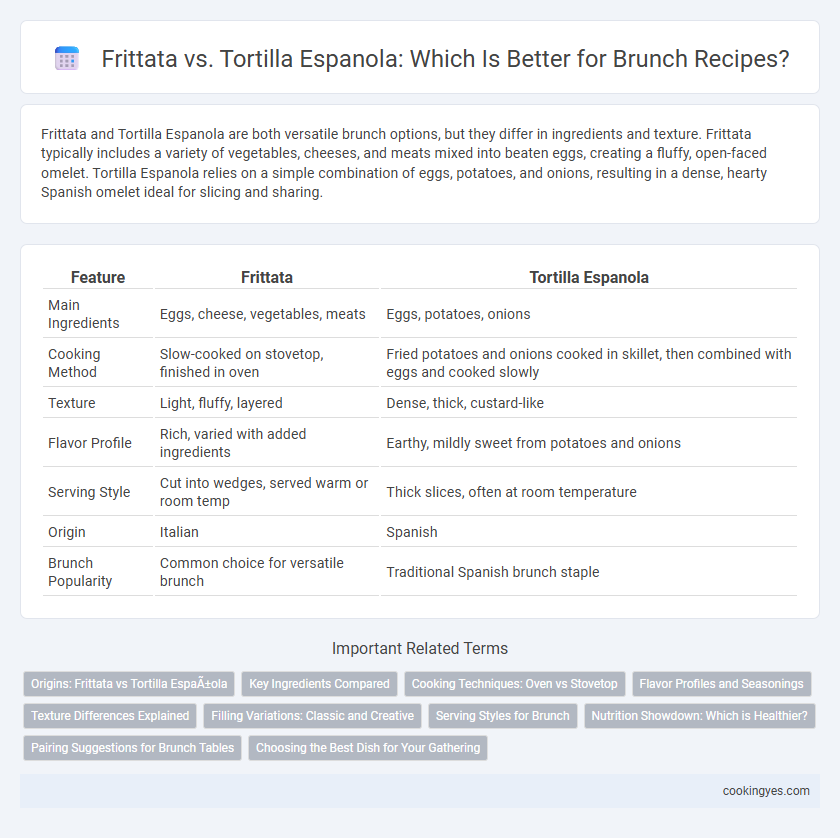Frittata and Tortilla Espanola are both versatile brunch options, but they differ in ingredients and texture. Frittata typically includes a variety of vegetables, cheeses, and meats mixed into beaten eggs, creating a fluffy, open-faced omelet. Tortilla Espanola relies on a simple combination of eggs, potatoes, and onions, resulting in a dense, hearty Spanish omelet ideal for slicing and sharing.
Table of Comparison
| Feature | Frittata | Tortilla Espanola |
|---|---|---|
| Main Ingredients | Eggs, cheese, vegetables, meats | Eggs, potatoes, onions |
| Cooking Method | Slow-cooked on stovetop, finished in oven | Fried potatoes and onions cooked in skillet, then combined with eggs and cooked slowly |
| Texture | Light, fluffy, layered | Dense, thick, custard-like |
| Flavor Profile | Rich, varied with added ingredients | Earthy, mildly sweet from potatoes and onions |
| Serving Style | Cut into wedges, served warm or room temp | Thick slices, often at room temperature |
| Origin | Italian | Spanish |
| Brunch Popularity | Common choice for versatile brunch | Traditional Spanish brunch staple |
Origins: Frittata vs Tortilla Española
Frittata originates from Italy, traditionally made by blending eggs with ingredients like cheese, vegetables, and meats, then cooked slowly to create a thick, open-faced omelet. Tortilla Espanola, or Spanish omelet, hails from Spain and is distinguished by its core ingredients--eggs, potatoes, and onions--fried together to form a dense, hearty dish. Both dishes showcase regional egg-based culinary techniques reflecting Mediterranean influences, yet differ in texture and ingredient composition rooted in their respective cultural origins.
Key Ingredients Compared
Frittata includes eggs, cheese, vegetables, and often meats like sausage or bacon, providing a rich and versatile base for brunch recipes. Tortilla Espanola primarily features eggs, potatoes, and onions, creating a hearty and dense texture distinct from the lighter, fluffier frittata. Both dishes are egg-based but differ in ingredient ratios and cooking methods, impacting flavor and consistency in brunch menus.
Cooking Techniques: Oven vs Stovetop
Frittata is typically finished in the oven after starting on the stovetop, allowing for even cooking and a fluffy texture, while Tortilla Espanola is cooked entirely on the stovetop with slow, controlled heat to achieve a dense, firm consistency. The oven method in frittata recipes helps set the eggs evenly and incorporates toppings like cheese and vegetables seamlessly. In contrast, Tortilla Espanola requires careful flipping to cook both sides through, emphasizing a more hands-on stovetop technique.
Flavor Profiles and Seasonings
Frittata features a creamy texture with a rich blend of eggs, cheese, and fresh herbs like basil or chives, offering a subtle yet savory flavor ideal for versatile brunch creations. Tortilla Espanola is characterized by its hearty combination of potatoes, onions, and olive oil, delivering a robust, earthy taste with a slightly sweet undertone from caramelized onions. Seasoning in frittata leans toward mild herbs and cheeses, while the tortilla emphasizes simplicity, highlighting the natural flavors of its key ingredients.
Texture Differences Explained
Frittata features a light, fluffy texture due to beaten eggs and slow cooking, creating an airy consistency ideal for brunch. Tortilla Espanola has a denser, creamier texture from the combination of fried potatoes and eggs, offering a heartier mouthfeel. The contrast in textures makes frittata crispier on the edges while tortilla Espanola remains more cohesive and moist throughout.
Filling Variations: Classic and Creative
Frittata offers versatile filling variations, ranging from classic combinations like spinach, cheese, and mushrooms to creative options such as smoked salmon with dill or roasted vegetables with feta. Tortilla Espanola traditionally features potatoes and onions, providing a simple, hearty base that can be enhanced with chorizo or peppers for added flavor. Both dishes allow for customizable ingredients to suit diverse brunch menus, balancing traditional tastes with innovative twists.
Serving Styles for Brunch
Frittata is typically served open-faced and sliced into wedges, making it ideal for sharing in a casual brunch setting. Tortilla Espanola, a Spanish potato omelette, is often served in thicker slices, showcasing its layered texture and hearty ingredients, perfect for a more rustic presentation. Both dishes pair well with fresh greens and bread, but frittata's versatility allows for individual portion customization, while tortilla espanola invites communal dining.
Nutrition Showdown: Which is Healthier?
Frittata, rich in protein and lower in carbohydrates, offers a nutrient-dense option with vitamins from vegetables and less oil compared to Tortilla Espanola, which contains higher levels of fat due to fried potatoes. Both dishes provide valuable nutrients, but frittatas typically deliver more fiber and antioxidants when loaded with fresh vegetables. Choosing frittata supports a balanced meal with fewer calories and less saturated fat, ideal for a healthier brunch option.
Pairing Suggestions for Brunch Tables
Frittata's rich, creamy texture pairs excellently with fresh fruit salads and light arugula or mixed greens, enhancing its egg-forward flavor ideal for versatile brunch spreads. Tortilla Espanola, with its hearty potato base and caramelized onions, complements robust charcuterie boards and Spanish-style roasted vegetables, adding a savory depth perfect for rustic brunch tables. Both dishes benefit from accompanying crisp white wines or sparkling roses that balance their unique flavor profiles and bring brightness to varied brunch pairings.
Choosing the Best Dish for Your Gathering
Frittata offers a versatile brunch option with its customizable ingredients and fluffy texture, ideal for accommodating diverse dietary preferences. Tortilla Espanola, traditionally made with potatoes and onions, provides a hearty, savory flavor that pairs well with simple sides and Spanish-inspired gatherings. Selecting between the two depends on your guests' tastes and the desired brunch atmosphere, where frittata suits casual, ingredient-flexible menus and tortilla espanola enhances culturally themed spreads.
Frittata vs Tortilla Española for Brunch Recipes Infographic

 cookingyes.com
cookingyes.com